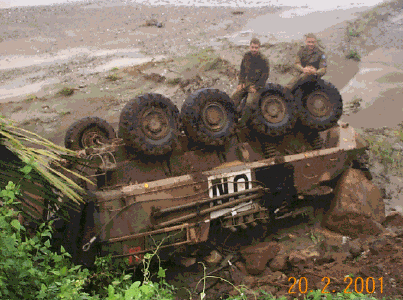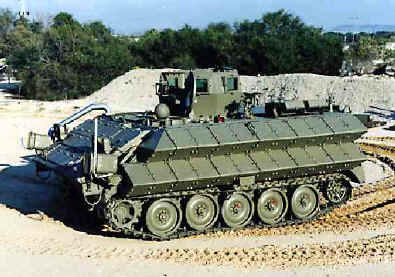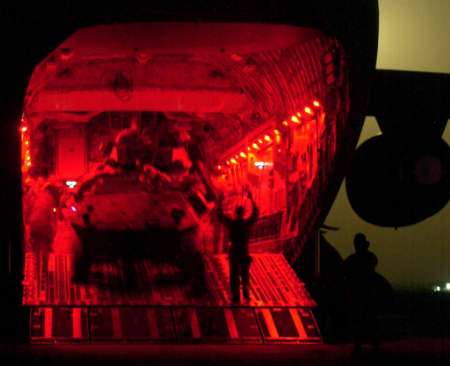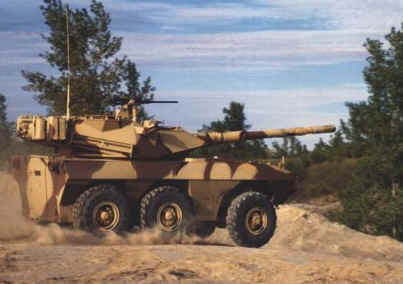"Know the
enemy, know yourself, your victory will never be endangered;
Know the ground, know the weather, your victory will then be total."
The perils of
technological arrogance
America's Army is at the crossroads of such a fatal delusion with the "transformation" vision put forth by Army Chief of Staff General Eric Shinseki that all its combat vehicles should become rubber-tired armored cars within the next 10 years with the purchase of the 19-ton LAV-III armored car for the interim Brigade Combat Teams. Because we think battles will be fought our high-tech way, we do not grasp history or reality. Such is the case with the lust to move the entire sustained land combat power of the United States Army by rubber-tired, wheeled armored cars. We believe that because we will "mouse-click" icons and direct firepower to distant locations, and a computer in the LAV-III armored car platform is more important than the Soldiers and vehicle itself.
I term this style of artillery and infantry warfare, "Bombard & Occupy" or BO as in the pejorative of the smell of the dead U.S. Soldiers this delusion will create. Occupation after bombardment is another form of peacekeeping punctuated by brief, minor incidents of violence quelled by a few ground troops. That we expect and make our future ground force structures dependant on all future enemies collapsing from bombardment is a fatal delusion and a clear and present danger.
The perils of
forgotten mechanical advantage
“The
primary purpose of an Army - to be ready to fight effectively at all times -
seemed to have been forgotten.... The leadership I found in many instances was
sadly lacking and I said so out loud. The unwillingness of the Army to forgo
certain creature comforts, its timidity about getting off the scanty roads, its
reluctance to move without radio and telephone contact, and its lack of
imagination in dealing with a foe whom they soon outmatched in firepower and
dominated in the air and on the surrounding seas – these were not the fault of
the Soldier, but of the policymakers at the top.”

The LAV-III 8x8 armored car is a 20-ton (combat-loaded) metal box suspended on top of 8 rubber tires which press down hard on the earth; 40 PSI to be exact. A vehicle pressing down on just 8 small areas can roll fast on pavement, but it cannot drive at will off-road in mud where it must grip. Except in the firm soil desert areas and roads, the LAV-III will get stuck often, ruining the tactical integrity of units and result in route selection where only clearly defined roads and paths will be selected. What we can anticipate is "GO" terrain for wheeled vehicles is also "GO" locations to set up an ambush and wait for vulnerable wheeled targets appear.
One argument for wheels is the "bad rap" tracked AFVs have gotten from the ultra-heavy M1 tanks and M2 Bradleys. Today's Army Generals are decades removed from actually commanding lighter mounted units in challenging, realistic, cross-country combat force-on-force maneuvers. No one has the moral courage to tell General Shinseki and his wheeled armored car fanatics that they are wrong, and have set the Army on a course to self-destruction. In fact, all professional debate is discouraged and no transformation consensus sought, it's either "go along" with the wheeled madness or "get the hell out of the way".
We still live on the same planet
where soft mud, rain, vegetation,
obstacles and enemy fire effects make it just as necessary today as it was in
WWI when we stopped trying to drive wheeled
armored cars through the mud and barbed wire of "no man's land" and armies adopted the track-laying tank. What
was good ground combat maneuver mobility for 1917 is essentially the same for
2017: the low-ground-pressure track. That we can fully
exploit this with modern material "band-track"
technology to be stealthy, facilitate high road speeds, and low-maintenance has been lost to those suffering from the
heavy M1/M2 tank "hang-over"
of the Cold War. That tracked armored vehicles are 28% more space/weight
efficient than wheeled armored cars, and are fully
C-130 aircraft transportable, and superior in armored protection (defeating
Rocket Propelled Grenade anti-tank missiles), armament and mobility is
lost on those officers who simply have not done their "homework".
The Perils of Combat
A careful examination of current events in Afghanistan,
shows that precise bombardment did not destroy most of the al Qaeda terrorists. So far, we have been blessed to have a
proxy Army to do our ground maneuver to seize control of the the lawless land. Without them, our air campaign would resemble
the futility of Kosovo in 1999. But now its clear Americans will have to ground
maneuver if we want to win (finish the job) and destroy the terrorists in
Afghanistan. That the U.S. Army in 1999 realized it needed a "medium" force with the best attributes of light and heavy is
commendable. U.S. Army Europe realized
the essence of the problem and created C-130 transportable forces using M113A3 Gavin
type tracked AFVs THAT ARE COMBAT-READY NOW. However, senior Army leaders refused to
modernize more of the
17,500 M113s tracked AFV the Army already owns. We should have M113A3 Gavin-based
brigades deep inside Afghanistan
today. Unlike the Northern Alliance which uses light BMP and medium T-55 tracked
tanks, bicycles, horses and donkeys to cross large, open areas and still have
off-road mobility when rocky elevations are encountered, U.S. Soldiers and
Marines have to move on foot or in vulnerable
rubber-tired LAVs through the world's most mined and contaminated unexploded ordnance areas. Anyone familiar with the dismal performance of the BTR series
8x8 armored car in Afghanistan would know
this--just look at their burned-out hulks littering the countryside on TV news
reports. As a result, the current Russian Army is moving away from wheeled armored cars
to tracks.
Senior leaders spend more time studying political persuasion tactics to secure their budgets, power and prestige in "battles" on Capital Hill than actual real-world combat operations. An "Army values" key chain that they order each Soldier to have on his person at all times is not enough of a reminder to them to make them do the right thing on this issue.
The perils of
ignoring the 3rd dimension of maneuver
Even an empty LAV-III is 1,000 pounds over the C-130's short field landing airstrip16-ton limit. This is not even the "Interim Armored Vehicle" (IAV) the Army says it wants to buy, which will be 20 tons after crammed with computers and other gadgets on top of fuel weight, the driver and vehicle commander, 9-man infantry squad and their 11 rucksacks full of ammo, water, food. Assuming the 105 inch wide LAV-III can even fit into the 105 inch floor of a C-130, at 20 tons combat loaded, its can only land on large modern concrete runways without damaging its landing gear and airframe. The C-130 will have to trade four tons of fuel just to take off with a combat-loaded LAV-III. The LAV-III's weight will essentially render it non-C-130 transportable by default.
The Marine Corps LAV-I is lighter at 11 tons and C-130 transportable, but any bullet larger than an "AK-47" (AKM, 7.62mm x 39mm) punctures its body and all fragments and bullets defeat its tires. We might be able to get LAV-Is to the conflict just to have them become the flaming coffins for our men, as two vehicles hit in the 1991 Gulf War demonstrated, claiming 11 lives. Trying to add 14.5mm of heavy machine gun protection on the LAV-III's body with require 7 tons of appliqué armor---however, the 8 air-filled, rubber tires are still vulnerable rendering the LAV-III a "mobility kill" and at 27 tons, the C-130 cannot even take off with it. That no other armored car in the world has applique armor fitted, and that the engine and suspension of the LAV-III cannot even move 7 extra tons of armor weight has not stopped official Army spokesmen from claiming publicly the LAV-III is 14.5mm HMG protected.
The
perils of ignoring the M113A3 
The truth is that the Army's 10.5 ton empty M113A3 Gavins (left) can be fitted with RPG and anti-tank protective applique' armor and full combat load of ammo, fuel, rucksacks while still remaining C-130 transportable by both airland and parachute airdrop. Furthermore, once in the combat area, Army CH-47F Chinook helicopters can sling-load M113A3s into battle for "Air-Mechanized" maneuvers that slice the enemy's forces into pieces. For about $200,000 a M113 can be upgraded with RPG-resistant applique armor, a 25mm autocannon and Javelin top-attack, fire & forget ATGM missile turret, stealthy, no-maintenance band tracks, infared "thellie" camouflage and have a computer screen to do digital warfare compared to a $2,000,000 LAV-III armored car of inferior physical capabilities. A full 9-man infantry squad can be carried inside, the M113A3 Gavin Fighting Vehicle with firepower superior to a M2 Bradley while still fully C-130 air-transportable. Up-armored SUSVs (BV-206S) are in production for over a dozen NATO/allied countries and cost about $400,000 each.
The Army may waste a billion dollars to fit a 105mm gun on a LAV-III, after the hull is being cut-down and kneeling suspension fitted (more weight). That this will even work after 3 years of redesign work is questionable since the Marine Corps tests on the concept failed, and MOWAG determined that ten wheels were needed to carry a 105mm gun. That money could outfit an M113A3 brigade within 3 years, or used to procure the the superb, Army-type classified and ready-for-production, M8 Armored 105mm Gun System (AGS) light tank. If you want a taste of the corrupt politics involved in this LAV-III scam, just go back to the September issue of G2mil and read the editorial "Shinseki's Light Armor Scam".
In 1948, famous British military historian B.H. Liddell Hart wrote about his post-war interviews with German Generals in a book "The German Generals Talk". In Chapter 8 he writes about the 1941 German invasion of the Soviet Union:
"The Germans lost the chance of victory because they had based their mobility on wheels instead of on tracks. On these mud-roads the wheeled transport was bogged when the tanks could move on. Panzer forces with tracked transport might have overrun Russia's vital centres long before autumn, despite the bad roads. World War I had shown this need to anyone who used his eyes and his imagination."
He later wrote that even though the German
army was modern, "it had not yet caught up with
ideas that were twenty years old." Apparently, the U.S.
Army must relearn lessons that are now 80 years old. 
Mike Sparks dynamicpara@aol.com
Ed. Mike Sparks is a co-author of the recent book: "Air-Mech-Strike" More information can be found at his M113A3 website, LAV Danger website, and Wheels vs Tracks website.
G2mil Update
Many Soldiers were upset that Marines were used
in the Afghan campaign. While the Marines were on the scene first, the
Army had over two months to assemble an airmobile force in the region. It
already has equipment stored in Qatar which could have been used. The Ar my
also has the ideal unit in Europe ready for such a mission. (see article
below).
my
also has the ideal unit in Europe ready for such a mission. (see article
below).
Soldiers really became angry when it became apparent that Marines were mostly deployed 400 miles into Afghanistan by USAF transports. Marines and equipment were disembarked in the Persian Gulf and boarded C-17s at a fixed airbase. This can't be blamed on interservice rivalry because the overall commander, General Franks, is an Army officer. Some Soldiers believe that if the Army deployed by air with heavy tanks and M113s AFVs, Congress would question why the Army needed to spend $5 billion for new LAVs. Now Army Generals can say they need LAVs, like the Marines used in Afghanistan, for such missions. It was interesting to note that C-17s were used to fly Marine LAVs, not C-130s. (actual photo right)
Marines are deployed on ships to provide sea-based rapidly deployable forces. They should not be committed to inland campaigns when Army units are available because that eliminates their unique ability for responding in other parts of the world. As a result, the Army plans to deploy units from the 101st Division to replace the Marines. This will probably become another permanent Army mission used to justify the large peacetime Army, like the "temporary" deployments to Bosnia and then Kosovo. Despite assurances from President Bush that Americans will succeed because we have no desire to keep territory, it seems the USA will establish large permanent post-war bases in Afghanistan, like we did in Cuba, Italy, Germany, Japan, Korea, Kuwait, Saudi Arabia, Bahrain, Qatar, UAE, Bosnia, and Kosovo.
The only other reason may be that Bush plans to expand this war soon and the Army is needed elsewhere. This logic is supported by the deployment of 3rd Army headquarters from Georgia to Kuwait, and the fact that 50,000 reservists remain mobilized a month after prospects for major fighting in Afghanistan ended. The most likely target: Pakistani nuclear weapons, with secret help from India.
USAREUR's Ready Force (Nov 2001 article)
(from
the US Army at http://www.dtic.mil/soldiers/nov2001/features/lariat2.html)
THE
Immediate Ready Force was established to improve USAREUR's ability to rapidly
respond to potential contingencies within the European Command's area of
responsibility. The cornerstone of the IRF is the Light Immediate Ready Company from the 1st
Battalion, 508th Infantry Regiment, in Vicenza, Italy. This airborne force is
deployable within 24 hours and can be quickly reinforced with additional units
from SETAF's 173rd Brigade. The remainder of the IRF is tailored into
Force Enhancement Modules (FEM)s that add
specific capabilities in the form of combat power, communications, military
police, engineers, scouts, and tactical or strategic control assets. The FEMs can deploy separately or together, based on the mission, to provide a
capable, tailorable and integrated force.
Combat power ranges from the Medium Ready Company, equipped with M113 armored personnel carriers, to the Heavy Immediate Ready Company, equipped with M1A1 tanks and Bradley fighting vehicles. Key to the mobility of the IRF is its ability to deploy using tactical airlift assets already available in the European theater, belonging to U.S. Air Forces Europe. Every IRF FEM is C-130 deployable, with the exception of the HIRC, which requires heavy-lift capability in the form of C-17 or C-5A transport aircraft. The successful partnership between USAREUR and USAFE, working together to meet the needs of the EUCOM commander, has been an essential part of the development and employment of the IRF.
Also key to the readiness and rapid deployment of the IRF is the prepositioning of equipment at the Deployment Processing Center. Located at Rhine Ordinance Barracks, the DPC stocks complete equipment sets for the FEMs, maintaining them at a 100 percent readiness rate. The location of ROB, adjacent to Ramstein Air Base, the primary aerial port of embarkation in Germany's Central Region, helps speed the delivery of IRF personnel and equipment anywhere they are needed.
Major Paul Swiergosz
Editor Comment
While General Dynamics spends millions of taxpayer dollars to tinker with its ultra-expensive LAV-III so it can squeeze into a C-130, one wonders why Textron doesn't complain. The Army claimed to want a proven "off-the-shelf" LAV as an "interim" vehicle, and Textron has been selling a smaller six-wheeled LAV with a 105mm low-recoil gun on the overseas market for years. The Marine Corps had already tested a 105mm gun on the eight-wheeled LAV chassis General Dynamics will use, and found it too unstable. However, the Army bought off objections by ordering some armored cars from Textron too, called the Armored Security Vehicle. Now the Army will have two types of armored cars, which costs much more since they require different parts, different mechanics, even different tires.
Carlton Meyer editorG2mil@Gmail.com
Use light trucks instead of light armorI've read numerous articles on lightening the Army. As a career soldier first in Armored Cav, then in Special Ops, and now in the illustrious field of Signal Operations. Maybe you should do some research with real soldiers and not senior officers or pet project managers. There are no soldiers in the US Army willing to go to a barbeque in the most advanced M-113; the slow, ill handling, non-defensible death trap that it is. Real soldiers know that there are two kinds of soldier: the quick and the dead. The LAV has major short comings when tested as a tank. But as a APC, it does have the asset of speed. Sorry to inform you but that is what soldiers in the field want, need and do not have.
Your documentation of the financial follies of
the Army/Industry are very interesting, but do nothing for soldiers in the
field. If a soldier does not have confidence in his equipment, he will not
fight well. So lets address the major issue of US defense. A
separate Transportation service is needed free of internal Army, Air Force,
Marine, and Navy interference. This would be nice, but would never happen. So,
lets deactivated one half of the Germany based Heavy units, forward deploy those
assets. Move our Stateside divisions to a Light, Medium and Heavy configuration.
Rework the SF community and the 82nd/Marine Team for forced entry only.

The M1A1 is every bit as good as any foreign tank, the F-15 can stand up to any adversary out there (they maybe old but there are 177 at Davis-Monthan AFB with less than 6 years on the airframe). Capital transport aircraft are a premium. Bulk transport of supply can be economically met by C-141 re-engined with 2 high bypass turbo fans. The European Airbus Transporter is 6 years away, but really can land at unimproved airfields. We can fight light and win. All it will take is a Congress that allows no overrun on ALL defense contracts.
Here is a the real scout vehicle ALL 19Ds are waiting for (left). This is the Australian Long-range scout vehicle. It is used all over the outback and is now the preferred police cruiser of East Timor. They run them them as the forward element, ahead of a mixed LAV & 20mm M-113 team, punch is provided by the attack helicopters. Speed, punch and agility, I wonder who could use that? The vehicle is on a 6X6 Land Rover chassis and is powered by a turbo diesel rated at 305HP. Road speed is over 130kph and cross country in heavy sand is approx 40kph. In scout config, it mounts one .50 M2 Browning MG as well as a 7.62 FN MAG, 4 personal weapons, 6 AT4s, night vision, long range listening devices, and one 500cc 4-stroke scout/messenger dirt bike (What a recruiting tool young soldiers on dirt bikes). Some also carry a 82mm mortar. One version also mounts 8 106mm Recoilless rifles like a modern Ontos Vehicle.
Robert Fritts
Ed. I'm not an advocate of the M113 either, even though the A3 version is much better. I'd want something that is UH-60L Blackhawk helicopter movable with steel front armor. I don't like the LAV as a warfighting attack platform because troops will get too aggressive and too afraid to dismount, so RPGs will chew them up. I like General Reimer's HMMWV idea (or your Land rover) so everyone knows to dismount when bullets start to fly.
LAV III fails Army C-130 requirement
The LAV III at 105 inches is too wide to fit into the 105
inch floor width of a C-130. At a 105 inches high, without a turret, it
needs air removed to possibly fit into the 102 inches the Air Force will give
it. The AF will give 104 inches for airdrop, but no more. The best
you could hope for is a vehicle with flat tires and those tires being very
narrow in order to squeeze the LAV III in.
Even if you could get the LAV III to fit inside a C-130, any
kind of turret on top will prevent this from happening. This is why the
MGS is going to have the hull cut down and the suspension to kneel. The
LAV III is 16.5 tons empty. Its already 1000 pounds to heavy for a C-130
to land it in a forward landing strip with enough fuel to fly back (e.g. it
would need to refuel at the strip). The situation is only going to get
worse when you try to make it kneel and try to add all that computer crap they
want. The bottom line is, the LAV III is not C-130 transportable in a
practical way. Just like the LAV I are not practical for CH-53Es to lift
them. They are paper bragging points, not real combat capabilities.
The road-bound LAV-III armored car
brigades concocted for the Army transformation are not OK for hunting terrorists
hiding in difficult terrain, where cross country travel, transportability by
fixed and rotary wing aircraft and ability to advance against enemy fire are
life/death requirements since the enemy is going to FIGHT BACK, not "throw
the towel in" like a wily Serb Army in Kosovo or disinterested Iraqi rabble
in Kuwait. If the Pentagon is putting up a brave face for the public,
fine. But it damn well better not be thinking of spending billions on
rubber tired LAV-III armored cars that will end up killing our men in
predictable ambushes, especially Afghans who had a field day firing up Russian
BTR 8x8 armored cars in their victory over the Red Army.
Mike Sparks dynamicpara@aol.com
LAV Scam
I also wrote a detailed article about the LAV III: Medium Brigade Flaws, and the Cure: The IBCT Revisited
Michael Robel
Ed. Yahoo News usually links my editorials, but failed to link "Shinseki's Light Armor Scam", even after two reminders from me. I thought they would love scandal, but now I realize I should have called it "The Army's Light Armor Scam" because all the politically correct nuts don't like to read negative things about a Japanese-American; or maybe they didn't like the criticism of potential advertisers; Generals Dynamic and Motors.